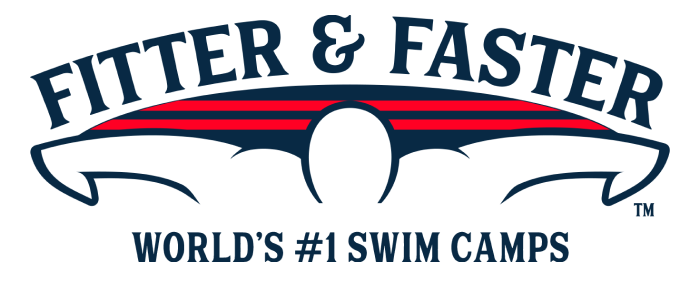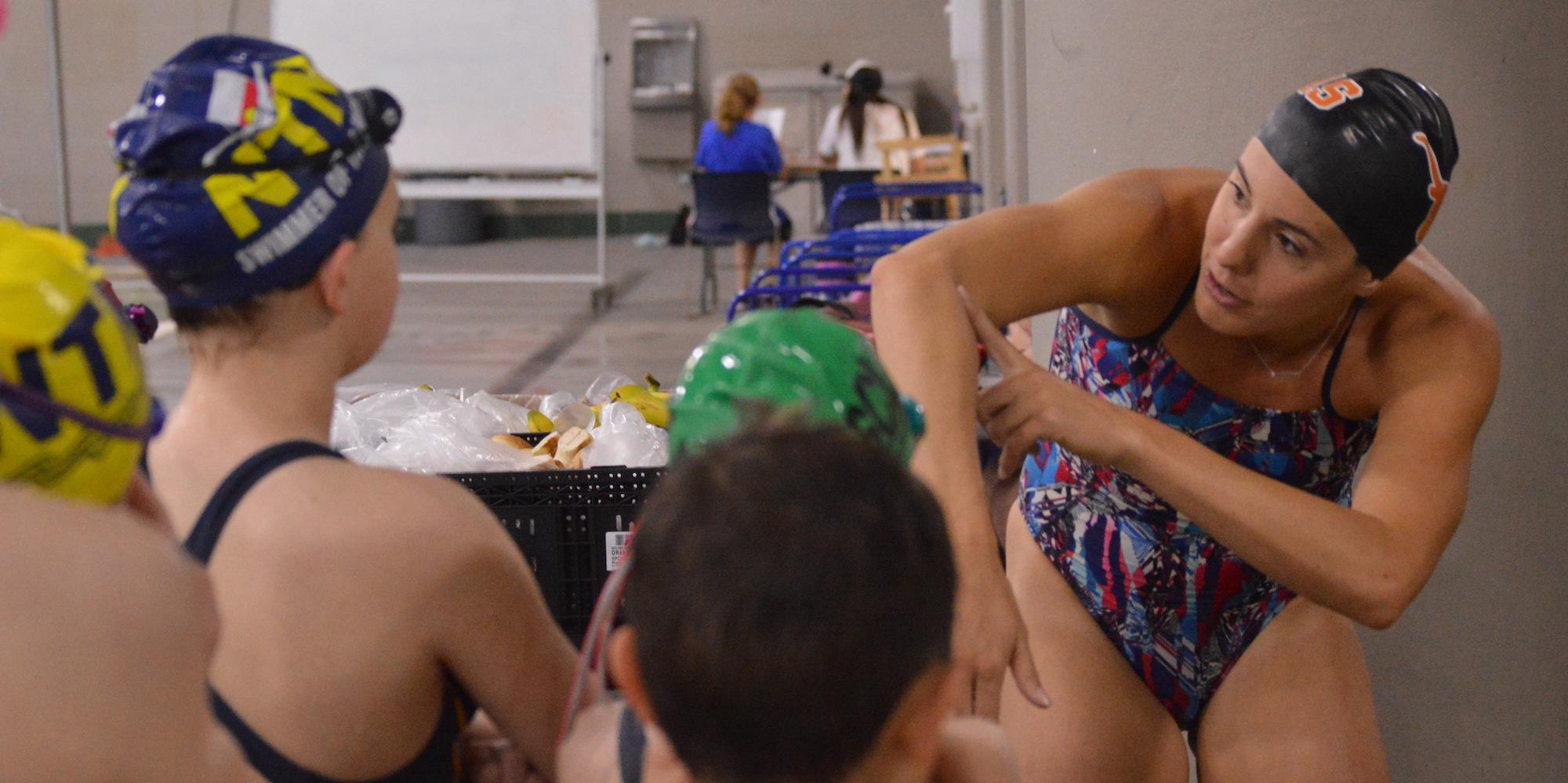
Swim camp curriculums
Each Fitter & Faster swim camp is customized to meet the needs of the intended competitive swimmers, coaches and teams.
We work with coaches, board members and/or other partners to best understand who the prospective participants are for each swim camp. From there we create world-class learning experiences with small session sizes.
Camps: A majority of Fitter & Faster swim camps are 2 to 3 days in a row. Camps of longer durations usually occur during winter breaks or the summer.
Sessions: Each day of camp usually consists of 2 sessions. So, 2-day camps are typically 4 total sessions. The key for participants to improve and retain information is to cover a narrow set of topics at each session.
Participants: Each session of a camp can be targeted to different ages or abilities. You can plan one curriculum for one age group… and plan something completely different on the same weekend for another age group. At some camps, all 4 sessions are designed for the same age group or ability level. Age, skill level and other factors are considered when creating the optimal “grouping of participants” for each session within each camp.
Since 2009, Fitter & Faster has been part of more than 250,000 competitive swimmers’ journey. In 2023 we produced 450 swim camps consisting of 1,800 sessions throughout all of North America. Many of our participants have gone on to compete in the NCAA; some have made Olympic Teams… and several are now clinicians for Fitter & Faster!
Below is a list of some of our most popular swim camp curriculums:
1. Popular Single Session Curriculums that are customized for all ages and abilities
(Ages 8 to 18+):
- Underwaters and breakouts
- Forward Starts, underwaters and breakouts
- Turns (flip and open) & Finishes
- Freestyle Technique
- Backstroke Technique
- Breaststroke Technique
- Butterfly Technique
- The Essentials of Sprinting
- The Essentials of Pacing
- Video Filming & Analysis (always added as a “5th” session to a traditional swim camp consisting of 4 sessions)
2. Single Session Curriculums for experienced/advanced competitive swimmers
(Generally, Ages 13 & up):
- All curriculums list above under #1
- Back to Breast Crossover turns
- Relay Exchanges
- Elite Start Technique Using Wedges & Handles
- Flat Wall Turns
- Technique with Delayed Video
- Race Analysis & Execution (Dry-side learning and Pool)
3. Explosive Starts and Turns Camps
- Day 1: Dives, underwater dolphin kicking, Breakouts
- Day 2: Flip turns, open turns, finishes
4. “Comprehensive” Swim Camps: Each Comprehensive camp focuses on just one stroke or technique for 2 to 3 sessions.
Popular Comprehensive Swim Camps include:
- Explosive Starts, Underwaters and Breakouts Swim Camp
- Fast turns (flip, open, IM transitions), Underwaters, Breakouts & Finishes Swim Camp
- Butterfly Technique and Racing Swim Camp
- Backstroke Technique and Racing Swim Camp
- Breaststroke Technique and Racing Swim Camp
- Freestyle Technique and Racing Swim Camp
Comprehensive Camp Summary:
- Day 1: Technique and drills (as appropriate for the participants of that session)
- Day 2: Applying speed to the stroke: Distance per stroke; tempo; pacing; sprint versus distance variations
- Day 3 (if applicable): Implementation of race strategies
5. Long Axis Camps (Freestyle and Backstroke)
- Day 1: Freestyle skills, drills and tempo
- Day 2: Backstroke skills drills and tempo
6. Short Axis Camps (Butterfly and Breaststroke)
- Day 1: Butterfly skills, drills, tempo
- Day 2: Breaststroke skills, drills, tempo
7. Video filming and Analysis:
(Ages 8 to Adult)
Video Filming sessions are added only other traditional camps as a 5th optional session for participants. Participants have their stroke filmed below the surface of the water! THEN, their video is analyzed with voice over and graphics on the actual video by an Elite Clinician or Olympic coach.
8. Speed and Power Camp
(Recommended for ages 12 & up):
- Day 1: Power; Dynamic warmup; Improving power in stroke technique
- Day 2: Speed
- Dryland for swimming
- Maintain technique through fatigue
- Speed training
- Recovery (nutrition, sleep, recovery techniques)
9. Race Analysis, Strategy & Execution Swim Camps
(Recommended for ages 12 & up)
Race Analysis, Strategy & Execution Camps are quickly becoming one of our most popular particularly among swimmers ages 13 through 17. How many times have you asked your coach “how should I swim this race?” This camp seeks to help the participant answer that question by learning how to analyze your own performances and applying different race strategies. Each session of each camp focuses on one specific race. These camps are less about a specific stroke and are more about the distance, mindset and execution of various strategies so that you will perform at a higher level. The most popular Race Strategy Camps across this USA are:
- The 100’s
- The 200’s
- 200 & 400 IM
- 500 Freestyle
- 50 Freestyle
10. Executing on Race Day: Success Through Habit Building and Accountability:
(For ages 10 & older with 2 or more years competitive experience)
The best swimmers in the world have the best details on race day. The secret to their success is understanding that execution under the physical and mental stress of competition is the result of daily habit building and accountability. This in-water camp will focus on important details of practicing and racing that your swimmer already knows about, but may not “execute regularly”. As they swim, athletes will learn the value of building positive habits that are similar to the best athletes in the world… and how to enlist those around them to hold them accountable during training.
11. Open Water Skills & Tactics:
Open water gives distance swimmers a fun and creative opportunity to earn recognition, enjoy the sport, and make zone, national, and international teams! While the races are challenging, the meets are among the most fun experiences in the sport. Participants in this swim camp will obtain open water swimming skills and knowledge. This camp is equally advantageous to new open water swimmers and those with extensive experience who are eager to have a leg up on the competition.
12. College Prep Camp:
(For Grades 8-12 and their parents)
Swimming in college is a wonderful experience and an important long-term goal for many athletes and their families. Whether you swim at the Division I, II, III or NAIA or Junior College level you can experience the thrill of travel, the intensity of competition and learn lessons and develop friendships which will last a lifetime. Through a combination of classroom and pool sessions, participants in this camp will learn how to navigate the recruiting process and choose a school that best meets their needs academically, athletically and socially. Participants will also learn high level swimming skills that are important for collegiate success but often missing in everyday training. This is a two day camp that will consist of four in-water and four classroom sessions (one for parents only). The College Prep Swim Camps are focused on guiding athletes through the information and in-water skills they need to progress to collegiate swimming. The camp includes sessions for parents to help you guide and support your swimmer through the college search process. This camp is for athletes in 8th through 12th grades who would like to swim in college.
13. Living as a 24-Hour Student/Athlete:
(Recommended for ages 13 & older)
This camp will help your competitive swimmer develop a lifestyle to improve performance in the pool and school. Elite performers are not only athletes during practice, they live their lives AS ATHLETES twenty-four hours a day. This camp will provide training and technique instruction and educate your swimmer on essential out-of-the water skills that will give them a competitive edge in High School and position them for success in college.
14. Training/Boot Camps
- Set your stroke up with drills for the first part of each session. Then, engage in a high intensity, dynamic training set specific to that particular camp’s focus.
- Swimmers are divided by sessions and lanes according to speed.
15. “Technique Academy”
- The “Technique Academy” consists of five individual clinic sessions over five days to improve ALL ASPECTS of participants’ racing
- Two clinic sessions each day for two sets of age groups (11 & under) and (12 and above)
- Session length: Sessions for swimmers ages 11 & under are usually 2-2.5 hours and the sessions for swimmers ages 12 and up are usually 3 hours.
Additional “add-on” topics for any swim camp:
♦ Meet preparation
(Swim Blog: The Final 24 Hours before race time)
♦ Balancing School and Swimming
(Swim Blog: Student Athlete Balance)
♦ Mental Preparation
(Swim Blog: Developing the Self-sufficient Athlete)
♦ Sprinting and racing skills
♦ Nutrition
(Swim Blog: Fueling a Fitter and Faster Swimmer)
(Swim Blog: Recovery Nutrition)
♦ Sessions for swim parents
(Swim Blog: Being a Supportive Swim Parent)
(Swim Blog: Swim Family, The Vanderkaays)
(Swim Blog: Swim Parent Perspective: Wildman-Tobriner)







